Lahore Junction railway station
Lahore Junction Station لاہور جنکشن ریلوے اسٹیشن | ||||||||||||||||
|---|---|---|---|---|---|---|---|---|---|---|---|---|---|---|---|---|
|
Lahore Junction Station Entrance | ||||||||||||||||
| Location |
Empress Road Lahore, Punjab 54000 | |||||||||||||||
| Coordinates | 31°34′38″N 74°20′11″E / 31.5772°N 74.3363°ECoordinates: 31°34′38″N 74°20′11″E / 31.5772°N 74.3363°E | |||||||||||||||
| Owned by | Ministry of Railways | |||||||||||||||
| Line(s) |
Karachi–Peshawar Railway Line Lahore–Wagah Branch Line | |||||||||||||||
| Platforms | 11 | |||||||||||||||
| Tracks | 11 | |||||||||||||||
| Connections |
| |||||||||||||||
| Construction | ||||||||||||||||
| Structure type | Standard | |||||||||||||||
| Other information | ||||||||||||||||
| Station code | LHR[1] | |||||||||||||||
| History | ||||||||||||||||
| Opened | 1860 | |||||||||||||||
| Services | ||||||||||||||||
| ||||||||||||||||
| Location | ||||||||||||||||
|
Lahore Junction Station Location within Lahore 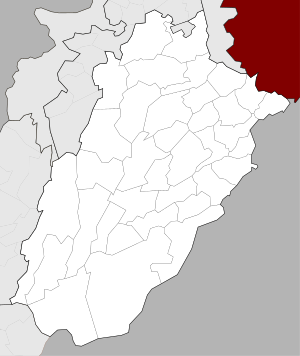 Lahore Junction Station Lahore Junction Station (Punjab, Pakistan)  Lahore Junction Station Lahore Junction Station (Pakistan) | ||||||||||||||||
Lahore Junction railway station (Urdu, Punjabi: لاہور جنکشن ریلوے اسٹیشن) is the main railway station in Lahore, Pakistan. Construction commenced shortly after the failed Mutiny of 1857 against British rule, and so was built in the style of a medieval castle with thick walls, turrets, and holes to direct gun and cannon fire for defence of the structure.[2] The station is now owned by Pakistan Railways, and also serves as its headquarters.
History

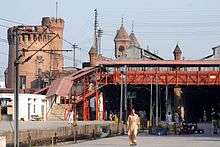
The station was built during the colonial era, and was built just outside the Walled City at the intersection of Empress Road, Allama Iqbal Road and Circular Road. Lahore Junction station was constructed by Mian Mohammad Sultan Chughtai, a former official of the Mughal Empire, between 1859-1860.
The station served as the headquarters for the Punjab Railway and later would serve as the northern terminus of the Scinde, Punjab & Delhi Railway, which connected the port city of Karachi to Lahore. It was built in the style of a medieval castle to ward off any potential future uprisings, as seen in the 1857 War of Independence, with thick walls, turrets, and holes to direct gun and cannon fire for defense of the structure.[3]
The station is a legacy of the extensive railway network established during the British Raj, and reflects the British contribution to the region's infrastructure. The station was severely affected during the riots which followed the Partition of the British Indian Empire and the independence of Pakistan in 1947. Similar to the contemporaneous situation of Muslims fleeing Delhi and Amritsar, Lahore's Hindus and Sikhs were sometimes attacked at Lahore's train station.
Facilities
Lahore Junction Station is equipped with all basic facilities such as ticketing services, restrooms, waiting areas, and international fast food chains. The station has current and advance reservation offices for Pakistan Railways, as well as freight and parcel facilities. Retail shops are found mainly on platforms 1 and 2, including restaurants such as Pizza Hut and McDonald's, in addition to restaurants offering Pakistani cuisine.
Services
The following trains originate/stop/terminate at Lahore Junction station:
| Preceding station | Pakistan Railways | Following station | ||
|---|---|---|---|---|
toward Quetta | Akbar Express | Terminus | ||
toward Karachi Cantonment | Allama Iqbal Express | toward Sialkot Junction |
||
toward Karachi Cantonment | Awam Express | toward Peshawar Cantonment |
||
| Terminus | Badar Express | toward Faisalabad |
||
toward Karachi City | Fareed Express | Terminus | ||
| Terminus | Ghouri Express | toward Faisalabad |
||
toward Quetta | Jaffar Express | toward Peshawar Cantonment |
||
toward Karachi Cantonment | Karachi Express | Terminus | ||
toward Karachi City | Karakoram Express | Terminus | ||
toward Karachi Cantonment | Khyber Mail | toward Peshawar Cantonment |
||
toward Karachi Cantonment | Night Coach Express | Terminus | ||
| Terminus | Rawal Express | toward Rawalpindi |
||
| Terminus | Pakistan Express | toward Rawalpindi |
||
toward Karachi Cantonment | Shalimar Express | Terminus | ||
| Terminus | Subak Kharam Express | toward Rawalpindi |
||
| Terminus | Subak Raftar Express | toward Rawalpindi |
||
toward Karachi Cantonment | Tezgam | toward Rawalpindi |
Gallery
 General View of Railway Station 1895 by William Henry Jackson
General View of Railway Station 1895 by William Henry Jackson- Far view of Railway Station in 1880s
 Fortifications of Railway Station 1895 by William Henry Jackson
Fortifications of Railway Station 1895 by William Henry Jackson
Railway Station in 1880s 
Railway Station Interior View 1880s 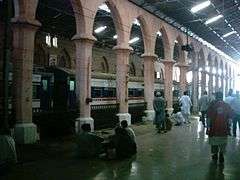
Train platform at Lahore Railway Station 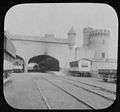 Lahore - entrance to railway station 1895
Lahore - entrance to railway station 1895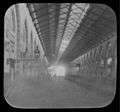 Lahore - interior of railway station 1895
Lahore - interior of railway station 1895 Lahore - general view of railway station 1895
Lahore - general view of railway station 1895
See also
References
- ↑ Official Web Site of Pakistan Railways
- ↑ Glover, William (January 2007). Making Lahore Modern, Constructing and Imagining a Colonial City. Univ of Minnesota Press. ISBN 978-0-8166-5022-4.
The Lahore station, built during a time when securing British civilians and troops against a future "native" uprising was foremost in the government's mind, fortified medieval castle, complete with turrets and crenellated towers, battered flanking walls, and loopholes for directing rifle and canon fire along the main avenues of approach from the city
- ↑ Glover, William (January 2007). Making Lahore Modern, Constructing and Imagining a Colonial City. Univ Of Minnesota Press. ISBN 978-0816650224.
The Lahore station, built during a time when securing British civilians and troops against a future “native” uprising was foremost in the government’s mind, fortified medieval castle, complete with turrets and crenellated towers, battered flanking walls, and loopholes for directing rifle and canon fire along the main avenues of approach from the city
External links
| Wikimedia Commons has media related to Lahore Railway Station. |
